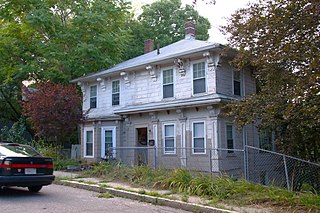
The House at 68 Maple Street is an historic building located on the corner of Maple Street and Nonantum Road in the village of Newton Corner, in Newton, Massachusetts. Built in the late 1840s, the two-story wood-frame building is a rare local example of a vernacular square hip-roofed Italianate house. Its most prominent features are its overscaled brackets, which decorate both the extended eaves and the roof line of the bay on the front facade.
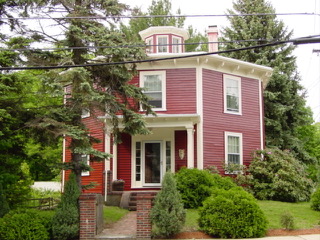
The William Bryant Octagon House is an historic octagon house located at 2 Spring Street in Stoneham, Massachusetts. Built in 1850, it is the best-preserved of three such houses built in the town in the 1850s. It was listed on the National Register of Historic Places in 1984.
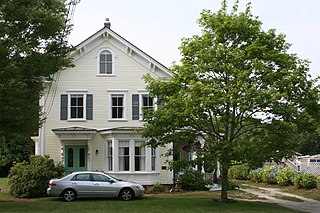
The Mercelia Evelyn Eldridge Kelley House is a historic house at 2610 Main Street in Chatham, Massachusetts. The 2+1⁄2-story wood-frame house was built in 1877 and has vernacular Italianate styling. It is significant for its association with the Eldridge family, who were major landowners in South Chatham and promoted its development. The house was listed on the National Register of Historic Places in 2005.

The Charles Browne House is a historic house located in North Adams, Massachusetts. Built in 1869, it was the home of Charles A. Browne Sr., inventor of the electrical fuse and an innovator of devices and materials used in construction of the nearby Hoosac Tunnel. The house is a well-preserved example of a local variant of Italianate architecture, and was listed on the National Register of Historic Places in 1985.

The Alexander Foster House is a historic house in Somerville, Massachusetts. Built c. 1860, it is one of the city's earliest examples of Italianate architecture, and one of its best-preserved. It was listed on the National Register of Historic Places in 1989.

The Alden Batchelder House is a historic house in Reading, Massachusetts. Built in the early 1850s, it is an excellent example of an early Italianate design. It was listed on the National Register of Historic Places in 1984.
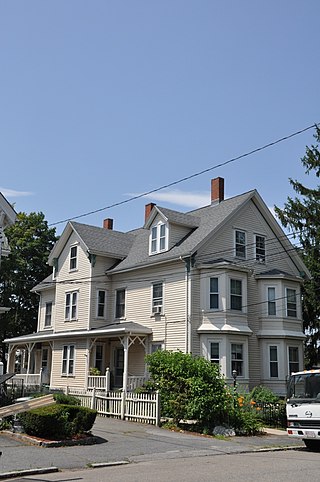
The Charles Baker Property is a historic house in Waltham, Massachusetts. Built about 1882, it is a well-preserved example of a period two-family residence built for workers of the American Watch Company. It was listed on the National Register of Historic Places in 1989.
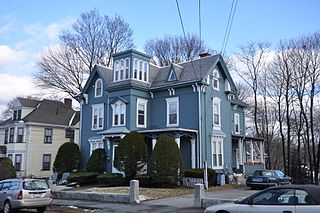
The Charles Wood House is a historic house at 30 Chestnut Street in Stoneham, Massachusetts. It is one of the most elaborate Italianate houses in Stoneham. The 2+1⁄2-story wood-frame house was built c. 1875 for Charles Wood, who lived there until the first decade of the 20th century. Its basic plan is an L shape, but there is a projecting section on the center of the main facade that includes a flat-roof third-story turret, and the roof line has numerous gables facing different directions. There are porches on the front right, and in the crook of the L, with Stick style decorations, the cornice features heavy paired brackets, some of its windows are narrow rounded windows in a somewhat Gothic Revival style, and the walls are clad in several types and shapes of wooden clapboards and shingles.

The Marcus Hobbs House is an historic house at 16 William Street in Worcester, Massachusetts. Built in 1849, it is an example of mid-19th century Greek Revival housing with added Italianate features. The house was listed on the National Register of Historic Places in 1980.
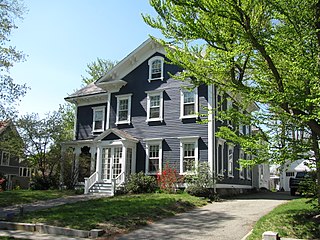
The House at 23 Avon Street in Wakefield, Massachusetts is one of the town's finest examples of Italianate. It was built about 1855, and was listed on the National Register of Historic Places in 1989.

The House at 21 Chestnut Street is one of the best preserved Italianate houses in Wakefield, Massachusetts. It was built c. 1855 to a design by local architect John Stevens, and was home for many years to local historian Ruth Woodbury. The house was listed on the National Register of Historic Places in 1989.
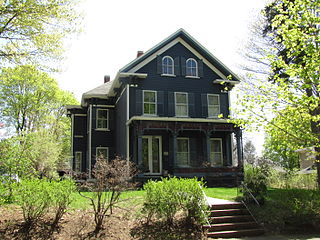
15 Wave Avenue is a well-preserved Italianate style house in Wakefield, Massachusetts. It was built between 1875 and 1883, and was listed on the National Register of Historic Places on July 6, 1989.

The Mayall Bruner House is a historic house at 36 Magnolia Avenue in the Newton Corner neighborhood of Newton, Massachusetts. Built in 1923, it is a well-preserved example of Craftsman architecture. It was listed on the National Register of Historic Places in 1990.

The House at 107 Waban Hill Road in eastern Newton, Massachusetts is one of the city's finest examples of formal Italianate styling, set high on Waban Hill with The two story wood-frame house was built c. 1875, and exhibits the full range of Italianate elements, including an extended bracketed eave, quoined corners, elaborate, heavily pedimented windows, and the shallow-pitch central gable on the flushboarded main facade. The main entrance is sheltered by an arched portico, and the roof is topped by a square cupola with bands of narrow round-arch windows on each side.
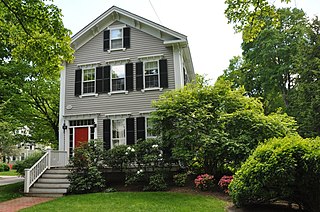
The House at 15 Davis Avenue in Newton, Massachusetts, is a well-preserved modest Italianate house. It is a 2+1⁄2-story wood-frame structure, whose features include paired brackets in the eaves, bracketed lintels above the doors and windows, and paneled corner pilaster strips. The main entrance is flanked by sidelight windows and topped by a transom. Likely built in the 1850s, this was probably one of the first houses built when Seth Davis began to sell off some of his landholdings.

The House at 3 Davis Avenue in West Newton, Massachusetts, is a well-preserved modest Italianate residence. It is a 2+1⁄2-story wood-frame house, three bays wide, with a front-facing gable roof. It was built c. 1853, and has an unusual amount of decorative trim for a modest house. The eaves and gables are studded with brackets, and the corners have quoining blocks. The front parlor windows, sheltered by a porch also studded with brackets, are of extended length.

The E. B. Cummings House is a historic house at 52 Marcy Street in Southbridge, Massachusetts. Built in the 1870s, it is an unusually late example of Greek Revival architecture with Italianate embellishments and later Victorian additions. The house was listed on the National Register of Historic Places on June 22, 1989.
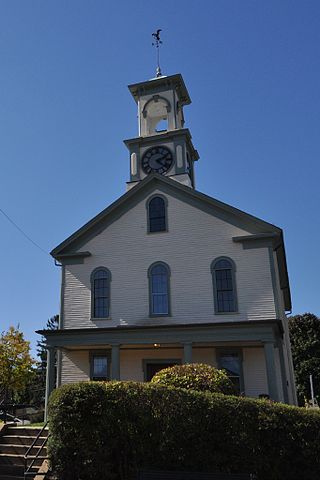
The South Meetinghouse is a historic ward hall at 260 Marcy Street in Portsmouth, New Hampshire. Completed in 1866, it is one of the city's finest examples of Italianate architecture, and a rare surviving example of a 19th-century ward hall. The building was listed on the National Register of Historic Places in 1982. It continues to be used as a community resource.
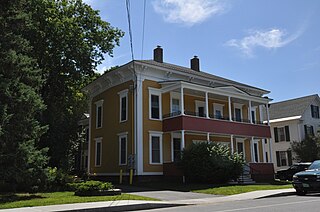
The Shearer and Corser Double House is a historic house at 592 Summer Street in St. Johnsbury, Vermont. Built as a school about 1854, it has had a history of varied uses and prominent local owners, and has high quality Colonial Revival and Italianate features. It was listed on the National Register of Historic Places in 1994.

The Mary Baker Eddy House is a historic house museum at 8 Broad Street in Lynn, Massachusetts. Built in 1870–71, it was the home of Mary Baker Eddy (1821-1910), founder of the Church of Christ, Scientist, from 1875 to 1882. The house is now owned by the church, which operates it as a historic site devoted to Eddy's life and early church history. The house was designated a National Historic Landmark in 2021, and was included in the Diamond Historic District in 1996.























